Black Carbon Aerosol in Rome (Italy): Inference of a Long-Term (2001–2017) Record and Related Trends from AERONET Sun-Photometry Data
Abstract
:1. Introduction
2. Material and Methods
2.1. Measurement Sites
2.2. Converting Light Absorption Columnar Data (AERONET) into Associated Surface Data (In-Situ)
2.2.1. Measurement of Columnar Aerosol Optical Properties
2.2.2. MLH Measurements
2.2.3. Converting Columnar Data into Surface Data
- (T1)
- AODEXT : we calculated its mean ( = 0.20) and standard deviation ( = 0.12) at the site of Rome Tor Vergata during the period 2001–2017 and then we selected only AODEXT values between and . In fact, in Rome AODEXT > are typically associated with increased aerosol layers from long-range transport of dust and/or fire plumes [11], while AODEXT < are found in northerly wind conditions, with a very clean atmosphere and too low AODEXT values to be trustworthy for our purposes;
- (T2)
- SSA: we selected only data with SSA values > 0.85. This is to exclude from the bulk aerosol the coarse mode dust (CDM) particles and the soot mode (STM) particles, according to the “paradigm” provided in [22];
- (T3)
- Reff : we selected only data with Reff values < 0.3 m in order to exclude dominance of larger particles, typical of Saharan dust transport conditions.
2.3. Validation Dataset
2.4. Converting the Aerosol Light Absorption Coefficient Into eBC Mass Concentration
- (i) the Absorption Ångström Exponent AAE (1,2) of BC = 1;
- (ii) the aerosol light absorption coefficient is affected by three different aerosol light absorbers: black carbon, brown carbon, and dust:
2.5. Trends Analysis Method
2.5.1. Mann-Kendall Test and Sen’s Slope
3. Results
3.1. Long-Term Records of Columnar Aerosol Optical Properties
3.2. Surface Absorption Coefficient Comparison between AERONET Inferences and In-Situ Measurements
3.3. Long-Term Record of Surface Aerosol Light Absorption Properties Inferred from AERONET Columnar Measurements
3.4. Long-Term Trends
- negative trend for AODEXT: −0.047/decade, with 90% uncertainty bounds of −0.065 and −0.029/decade;
- negative trend for AODABS: –0.007/decade, with 90% uncertainty bounds of −0.01 and −0.0041/decade;
- positive trend for SSA: +0.014/decade, with 90% uncertainty bounds of −0.0019 and 0.025/decade;
- negative trend for abs: −5.9 Mm−1/decade, with 90% uncertainty bounds of −9.7 to −2.1 Mm−1/decade;
- negative trend for eBC mass concentration: −0.76 /decade, with 90% uncertainty bounds of −1.2 to −0.28 /decade;
- negative trend for PM2.5: −5.2 /decade, with 90% uncertainty bounds of −6.7 to −3.8 /decade;
- negative trend for CO: −0.25 mg/m/decade, with 90% uncertainty bounds of −0.27 to −0.22 mg/m/decade.
4. Discussion
4.1. Influence of the Different Measurement Methods
- eliminated cases when the bulk aerosol was dominated by dust and/or fire plumes (see Section 2.2.3);
- analysed only data in the red region (wavelength of 660–675 nm), where the absorption due to brown carbon is expected to be negligible [60].
4.2. Influence of Atmospheric Conditions
- it does not consider the vertical inhomogeneity of the aerosol load within the MLH;
- MLH can be quite heterogeneous even at the urban scale, thus caution should be used in comparing ground values obtained at different locations using the same MLH value;
4.3. Comparison with Previous Studies
- eBC mass concentrations inferred from AERONET measurements are generally higher than those measured in-situ;
- minimum differences mostly occur during winter (MD of 22% at the site of Rome Villa Ada);
- largest differences occur in summer and spring (MD of 121% at the site of Rome Montelibretti).
5. Conclusions
Supplementary Materials
Acknowledgments
Author Contributions
Conflicts of Interest
References
- Ramanathan, V.; Carmichael, G. Global and regional climate changes due to black carbon. Nat. Geosci. 2008, 1, 221–227. [Google Scholar] [CrossRef]
- Janssen, N.A.; Gerlofs-Nijland, M.E.; Lanki, T.; Salonen, R.O.; Cassee, F.; Hoek, G.; Fischer, P.; Brunekreef, B.; Krzyzanowski, M. Health Effects of Black Carbon; WHO Regional Office for Europe Copenhagen: Copenhagen, Denmark, 2012. [Google Scholar]
- Graedel, T.; Allwood, J.; Birat, J.; Reck, B.; Sibley, S.; Sonnemann, G.; Buchert, M.; Hagelüken, C. A Report of the Working Group on the Global Metal Flows to the International Resource Panel, United Nations Environment Programme; UNEP Recycling Rates of Metals-A Status Report; UNEP: Nairobi, Kenya, 2011. [Google Scholar]
- Bond, T.C.; Doherty, S.J.; Fahey, D.; Forster, P.; Berntsen, T.; DeAngelo, B.; Flanner, M.; Ghan, S.; Kärcher, B.; Koch, D.; et al. Bounding the role of black carbon in the climate system: A scientific assessment. J. Geophys. Res. Atmos. 2013, 118, 5380–5552. [Google Scholar] [CrossRef] [Green Version]
- Smith, J.B.; Schneider, S.H.; Oppenheimer, M.; Yohe, G.W.; Hare, W.; Mastrandrea, M.D.; Patwardhan, A.; Burton, I.; Corfee-Morlot, J.; Magadza, C.H.; et al. Assessing dangerous climate change through an update of the Intergovernmental Panel on Climate Change (IPCC)“reasons for concern”. Proc. Natl. Acad. Sci. USA 2009, 106, 4133–4137. [Google Scholar] [CrossRef] [PubMed]
- Aquila, V.; Hendricks, J.; Lauer, A.; Riemer, N.; Vogel, H.; Baumgardner, D.; Minikin, A.; Petzold, A.; Schwarz, J.; Spackman, J.; et al. MADE-in: A new aerosol microphysics submodel for global simulation of insoluble particles and their mixing state. Geosci. Model Dev. 2011, 4, 325–355. [Google Scholar] [CrossRef] [Green Version]
- Reddington, C.; McMeeking, G.; Mann, G.; Coe, H.; Frontoso, M.; Liu, D.; Flynn, M.; Spracklen, D.; Carslaw, K. The mass and number size distributions of black carbon aerosol over Europe. Atmos. Chem. Phys. 2013, 13, 4917–4939. [Google Scholar] [CrossRef]
- Wild, M. Global dimming and brightening: A review. J. Geophys. Res. Atmos. 2009, 114, D00D16. [Google Scholar] [CrossRef]
- Stocker, T.F. Climate Change 2013: The Physical Science Basis: Working Group I Contribution to the Fifth Assessment Report of the Intergovernmental Panel on Climate Change; Cambridge University Press: Cambridge, UK, 2014. [Google Scholar]
- Struckmeier, C.; Drewnick, F.; Fachinger, F.; Gobbi, G.P.; Borrmann, S. Atmospheric aerosols in Rome, Italy: Sources, dynamics and spatial variations during two seasons. Atmos. Chem. Phys. 2016, 16, 15277–15299. [Google Scholar] [CrossRef]
- Barnaba, F.; Gobbi, G.P. Aerosol seasonal variability over the Mediterranean region and relative impact of maritime, continental and Saharan dust particles over the basin from MODIS data in the year 2001. Atmos. Chem. Phys. 2004, 4, 2367–2391. [Google Scholar] [CrossRef]
- Costabile, F.; Angelini, F.; Barnaba, F.; Gobbi, G.P. Partitioning of Black Carbon between ultrafine and fine particle modes in an urban airport vs. urban background environment. Atmos. Environ. 2015, 102, 136–144. [Google Scholar] [CrossRef]
- Barnaba, F.; Bolignano, A.; Di Liberto, L.; Morelli, M.; Lucarelli, F.; Nava, S.; Perrino, C.; Canepari, S.; Basart, S.; Costabile, F.; et al. Desert dust contribution to PM10 loads in Italy: Methods and recommendations addressing the relevant European Commission Guidelines in support to the Air Quality Directive 2008/50. Atmos. Environ. 2017, 161, 288–305. [Google Scholar] [CrossRef]
- Rizza, U.; Barnaba, F.; Miglietta, M.M.; Mangia, C.; Di Liberto, L.; Dionisi, D.; Costabile, F.; Grasso, F.; Gobbi, G.P. WRF-Chem model simulations of a dust outbreak over the central Mediterranean and comparison with multi-sensor desert dust observations. Atmos. Chem. Phys. 2017, 17, 93. [Google Scholar] [CrossRef]
- Costabile, F.; Alas, H.; Aufderheide, M.; Avino, P.; Amato, F.; Argentini, S.; Barnaba, F.; Berico, M.; Bernardoni, V.; Biondi, R.; et al. First results of the “Carbonaceous aerosol in Rome and Environs (CARE)” experiment: Beyond current standards for PM10. Atmosphere 2017, 8, 249. [Google Scholar] [CrossRef]
- Holben, B.; Eck, T.; Slutsker, I.; Tanre, D.; Buis, J.; Setzer, A.; Vermote, E.; Reagan, J.; Kaufman, Y.; Nakajima, T.; et al. AERONET—A federated instrument network and data archive for aerosol characterization. Remote Sens. Environ. 1998, 66, 1–16. [Google Scholar] [CrossRef]
- Dubovik, O.; King, M.D. A flexible inversion algorithm for retrieval of aerosol optical properties from Sun and sky radiance measurements. J. Geophys. Res. Atmos. 2000, 105, 20673–20696. [Google Scholar] [CrossRef]
- Dubovik, O.; Smirnov, A.; Holben, B.; King, M.; Kaufman, Y.; Eck, T.; Slutsker, I. Accuracy assessments of aerosol optical properties retrieved from Aerosol Robotic Network (AERONET) Sun and sky radiance measurements. J. Geophys. Res. Atmos. 2000, 105, 9791–9806. [Google Scholar] [CrossRef]
- Andrews, E.; Ogren, J.A.; Kinne, S.; Samset, B. Comparison of AOD, AAOD and column single scattering albedo from AERONET retrievals and in situ profiling measurements. Atmos. Chem. Phys. 2017, 17, 6041–6072. [Google Scholar] [CrossRef]
- Holben, B.; Eck, T.; Slutsker, I.; Smirnov, A.; Sinyuk, A.; Schafer, J.; Giles, D.; Dubovik, O. AERONET’s version 2.0 quality assurance criteria. In Proceedings of the Asia-Pacific Remote Sensing Symposium on International Society for Optics and Photonics, Goa, India, 8 December 2006. [Google Scholar]
- Angelini, F.; Gobbi, G.P. Some remarks about lidar data preprocessing and different implementations of the gradient method for determining the aerosol layers. Ann. Geophys. 2014, 57. [Google Scholar] [CrossRef]
- Costabile, F.; Barnaba, F.; Angelini, F.; Gobbi, G.P. Identification of key aerosol populations through their size and composition resolved spectral scattering and absorption. Atmos. Chem. Phys. 2013, 13, 2455–2470. [Google Scholar] [CrossRef]
- Barnaba, F.; Angelini, F.; Curci, G.; Gobbi, G.P. An important fingerprint of wildfires on the European aerosol load. Atmos. Chem. Phys. 2011, 11, 10487–10501. [Google Scholar] [CrossRef] [Green Version]
- Costabile, F.; Amoroso, A.; Wang, F. Sub-μm particle size distributions in a suburban Mediterranean area. Aerosol populations and their possible relationship with HONO mixing ratios. Atmos. Environ. 2010, 44, 5258–5268. [Google Scholar] [CrossRef]
- Bond, T.C.; Anderson, T.L.; Campbell, D. Calibration and intercomparison of filter-based measurements of visible light absorption by aerosols. Aerosol Sci. Technol. 1999, 30, 582–600. [Google Scholar] [CrossRef]
- Virkkula, A.; Ahlquist, N.C.; Covert, D.S.; Arnott, W.P.; Sheridan, P.J.; Quinn, P.K.; Coffman, D.J. Modification, calibration and a field test of an instrument for measuring light absorption by particles. Aerosol Sci. Technol. 2005, 39, 68–83. [Google Scholar] [CrossRef]
- Lack, D.A.; Cappa, C.D.; Covert, D.S.; Baynard, T.; Massoli, P.; Sierau, B.; Bates, T.S.; Quinn, P.K.; Lovejoy, E.R.; Ravishankara, A. Bias in filter-based aerosol light absorption measurements due to organic aerosol loading: Evidence from ambient measurements. Aerosol Sci. Technol. 2008, 42, 1033–1041. [Google Scholar] [CrossRef]
- Cappa, C.D.; Lack, D.A.; Burkholder, J.B.; Ravishankara, A. Bias in filter-based aerosol light absorption measurements due to organic aerosol loading: Evidence from laboratory measurements. Aerosol Sci. Technol. 2008, 42, 1022–1032. [Google Scholar] [CrossRef]
- Zhang, Q.; Jimenez, J.; Canagaratna, M.; Allan, J.; Coe, H.; Ulbrich, I.; Alfarra, M.; Takami, A.; Middlebrook, A.; Sun, Y.; et al. Ubiquity and dominance of oxygenated species in organic aerosols in anthropogenically-influenced Northern Hemisphere midlatitudes. Geophys. Res. Lett. 2007, 34, L13801. [Google Scholar] [CrossRef]
- Müller, T.A.; Henzing, J.; Leeuw, G.D.; Wiedensohler, A.; Alastuey, A.; Angelov, H.; Bizjak, M.; Collaud Coen, M.; Engström, J.; Gruening, C.; et al. Characterization and intercomparison of aerosol absorption photometers: Result of two intercomparison workshops. Atmos. Meas. Tech. 2011, 4, 245–268. [Google Scholar] [CrossRef] [Green Version]
- Schmid, H.; Laskus, L.; Abraham, H.J.; Baltensperger, U.; Lavanchy, V.; Bizjak, M.; Burba, P.; Cachier, H.; Crow, D.; Chow, J.; et al. Results of the “carbon conference” international aerosol carbon round robin test stage I. Atmos. Environ. 2001, 35, 2111–2121. [Google Scholar] [CrossRef]
- Nordmann, S.; Birmili, W.; Weinhold, K.; Müller, K.; Spindler, G.; Wiedensohler, A. Measurements of the mass absorption cross section of atmospheric soot particles using Raman spectroscopy. J. Geophys. Res. Atmos. 2013, 118, 12075–12085. [Google Scholar] [CrossRef]
- Kirchstetter, T.W.; Novakov, T.; Hobbs, P.V. Evidence that the spectral dependence of light absorption by aerosols is affected by organic carbon. J. Geophys. Res. Atmos. 2004, 109. [Google Scholar] [CrossRef]
- Costabile, F.; Gilardoni, S.; Barnaba, F.; Di Ianni, A.; Di Liberto, L.; Dionisi, D.; Manigrasso, M.; Paglione, M.; Poluzzi, V.; Rinaldi, M.; et al. Characteristics of brown carbon in the urban Po Valley atmosphere. Atmos. Chem. Phys. 2017, 17, 313–326. [Google Scholar] [CrossRef]
- Bahadur, R.; Praveen, P.S.; Xu, Y.; Ramanathan, V. Solar absorption by elemental and brown carbon determined from spectral observations. Proc. Natl. Acad. Sci. USA 2012, 109, 17366–17371. [Google Scholar] [CrossRef] [PubMed]
- Bergstrom, R.W.; Russell, P.B.; Hignett, P. Wavelength dependence of the absorption of black carbon particles: Predictions and results from the TARFOX experiment and implications for the aerosol single scattering albedo. J. Atmos. Sci. 2002, 59, 567–577. [Google Scholar] [CrossRef]
- Gyawali, M.; Arnott, W.; Lewis, K.; Moosmüller, H. In situ aerosol optics in Reno, NV, USA during and after the summer 2008 California wildfires and the influence of absorbing and non-absorbing organic coatings on spectral light absorption. Atmos. Chem. Phys. 2009, 9, 8007–8015. [Google Scholar] [CrossRef]
- Moosmüller, H.; Chakrabarty, R.; Ehlers, K.; Arnott, W. Absorption Ångström coefficient, brown carbon, and aerosols: Basic concepts, bulk matter, and spherical particles. Atmos. Chem. Phys. 2011, 11, 1217–1225. [Google Scholar] [CrossRef]
- Lack, D.; Langridge, J. On the attribution of black and brown carbon light absorption using the Ångström exponent. Atmos. Chem. Phys. 2013, 13, 10535–10543. [Google Scholar] [CrossRef]
- Shinozuka, Y.; Clarke, A.; DeCarlo, P.; Jimenez, J.; Dunlea, E.; Roberts, G.; Tomlinson, J.; Collins, D.; Howell, S.; Kapustin, V.; et al. Aerosol optical properties relevant to regional remote sensing of CCN activity and links to their organic mass fraction: Airborne observations over Central Mexico and the US West Coast during MILAGRO/INTEX-B. Atmos. Chem. Phys. 2009, 9, 6727–6742. [Google Scholar] [CrossRef]
- Schmeisser, L.; Andrews, E.; Ogren, J.A.; Sheridan, P.; Jefferson, A.; Sharma, S.; Kim, J.E.; Sherman, J.P.; Sorribas, M.; Kalapov, I.; et al. Classifying aerosol type using in situ surface spectral aerosol optical properties. Atmos. Chem. Phys. 2017, 17, 12097–12120. [Google Scholar] [CrossRef]
- Arola, A.; Schuster, G.; Myhre, G.; Kazadzis, S.; Dey, S.; Tripathi, S. Inferring absorbing organic carbon content from AERONET data. Atmos. Chem. Phys. 2011, 11, 215–225. [Google Scholar] [CrossRef]
- Gilardoni, S.; Massoli, P.; Paglione, M.; Giulianelli, L.; Carbone, C.; Rinaldi, M.; Decesari, S.; Sandrini, S.; Costabile, F.; Gobbi, G.P.; et al. Direct observation of aqueous secondary organic aerosol from biomass-burning emissions. Proc. Natl. Acad. Sci. USA 2016, 113, 10013–10018. [Google Scholar] [CrossRef] [PubMed]
- Stohl, A.; Klimont, Z.; Eckhardt, S.; Kupiainen, K.; Shevchenko, V.P.; Kopeikin, V.; Novigatsky, A. Black carbon in the Arctic: The underestimated role of gas flaring and residential combustion emissions. Atmos. Chem. Phys. 2013, 13, 8833–8855. [Google Scholar] [CrossRef] [Green Version]
- Bond, T.C.; Bergstrom, R.W. Light absorption by carbonaceous particles: An investigative review. Aerosol Sci. Technol. 2006, 40, 27–67. [Google Scholar] [CrossRef]
- Li, J.; Carlson, B.E.; Dubovik, O.; Lacis, A.A. Recent trends in aerosol optical properties derived from AERONET measurements. Atmos. Chem. Phys. 2014, 14, 12271–12289. [Google Scholar] [CrossRef]
- Mann, H.B. Nonparametric tests against trend. Econom. J. Econom. Soc. 1945, 13, 245–259. [Google Scholar] [CrossRef]
- Kendall, M. Multivariate Analysis; Charles Griffin: London, UK, 1975. [Google Scholar]
- Yue, S.; Pilon, P.; Phinney, B.; Cavadias, G. The influence of autocorrelation on the ability to detect trend in hydrological series. Hydrol. Process. 2002, 16, 1807–1829. [Google Scholar] [CrossRef]
- Zhang, X.; Zwiers, F.W. Comment on “Applicability of prewhitening to eliminate the influence of serial correlation on the Mann-Kendall test” by Sheng Yue and Chun Yuan Wang. Water Resour. Res. 2004, 40. [Google Scholar] [CrossRef]
- Bayazit, M.; Önöz, B. To prewhiten or not to prewhiten in trend analysis? Hydrol. Sci. J. 2007, 52, 611–624. [Google Scholar] [CrossRef]
- Redemann, J.; Russell, P.B.; Hamill, P. Dependence of aerosol light absorption and single-scattering albedo on ambient relative humidity for sulfate aerosols with black carbon cores. J. Geophys. Res. Atmos. 2001, 106, 27485–27495. [Google Scholar] [CrossRef]
- Adam, M.; Putaud, J.P.; Martins dos Santos, S.; Dell’Acqua, A.; Gruening, C. Aerosol hygroscopicity at a regional background site (Ispra) in Northern Italy. Atmos. Chem. Phys. 2012, 12, 5703–5717. [Google Scholar] [CrossRef]
- Brem, B.T.; Mena Gonzalez, F.C.; Meyers, S.R.; Bond, T.C.; Rood, M.J. Laboratory-measured optical properties of inorganic and organic aerosols at relative humidities up to 95%. Aerosol Sci. Technol. 2012, 46, 178–190. [Google Scholar] [CrossRef]
- Nessler, R.; Weingartner, E.; Baltensperger, U. Effect of humidity on aerosol light absorption and its implications for extinction and the single scattering albedo illustrated for a site in the lower free troposphere. J. Aerosol Sci. 2005, 36, 958–972. [Google Scholar] [CrossRef]
- Barnaba, F.; Putaud, J.P.; Gruening, C.; Dos Santos, S. Annual cycle in co-located in situ, total-column, and height-resolved aerosol observations in the Po Valley (Italy): Implications for ground-level particulate matter mass concentration estimation from remote sensing. J. Geophys. Res. Atmos. 2010, 115. [Google Scholar] [CrossRef]
- Yoon, S.C.; Kim, J. Influences of relative humidity on aerosol optical properties and aerosol radiative forcing during ACE-Asia. Atmos. Environ. 2006, 40, 4328–4338. [Google Scholar] [CrossRef]
- Moosmüller, H.; Chakrabarty, R.; Arnott, W. Aerosol light absorption and its measurement: A review. J. Quant. Spectrosc. Radiat. Transf. 2009, 110, 844–878. [Google Scholar] [CrossRef]
- Jacobson, M.Z. Short-term effects of controlling fossil-fuel soot, biofuel soot and gases, and methane on climate, Arctic ice, and air pollution health. J. Geophys. Res. Atmos. 2010, 115. [Google Scholar] [CrossRef]
- Lack, D.; Cappa, C. Impact of brown and clear carbon on light absorption enhancement, single scatter albedo and absorption wavelength dependence of black carbon. Atmos. Chem. Phys. 2010, 10, 4207–4220. [Google Scholar] [CrossRef] [Green Version]
- Sandrini, S.; Fuzzi, S.; Piazzalunga, A.; Prati, P.; Bonasoni, P.; Cavalli, F.; Bove, M.C.; Calvello, M.; Cappelletti, D.; Colombi, C.; et al. Spatial and seasonal variability of carbonaceous aerosol across Italy. Atmos. Environ. 2014, 99, 587–598. [Google Scholar] [CrossRef]
- Putaud, J.P.; Cavalli, F.; Martins dos Santos, S.; Dell’Acqua, A. Long-term trends in aerosol optical characteristics in the Po Valley, Italy. Atmos. Chem. Phys. 2014, 14, 9129–9136. [Google Scholar] [CrossRef] [Green Version]
- Collaud Coen, M.; Andrews, E.; Asmi, A.; Baltensperger, U.; Bukowiecki, N.; Day, D.; Fiebig, M.; Fjaeraa, A.; Flentje, H.; Hyvärinen, A.; et al. Aerosol decadal trends—Part 1: In-situ optical measurements at GAW and IMPROVE stations. Atmos. Chem. Phys. 2013, 13, 869–894. [Google Scholar] [CrossRef] [Green Version]
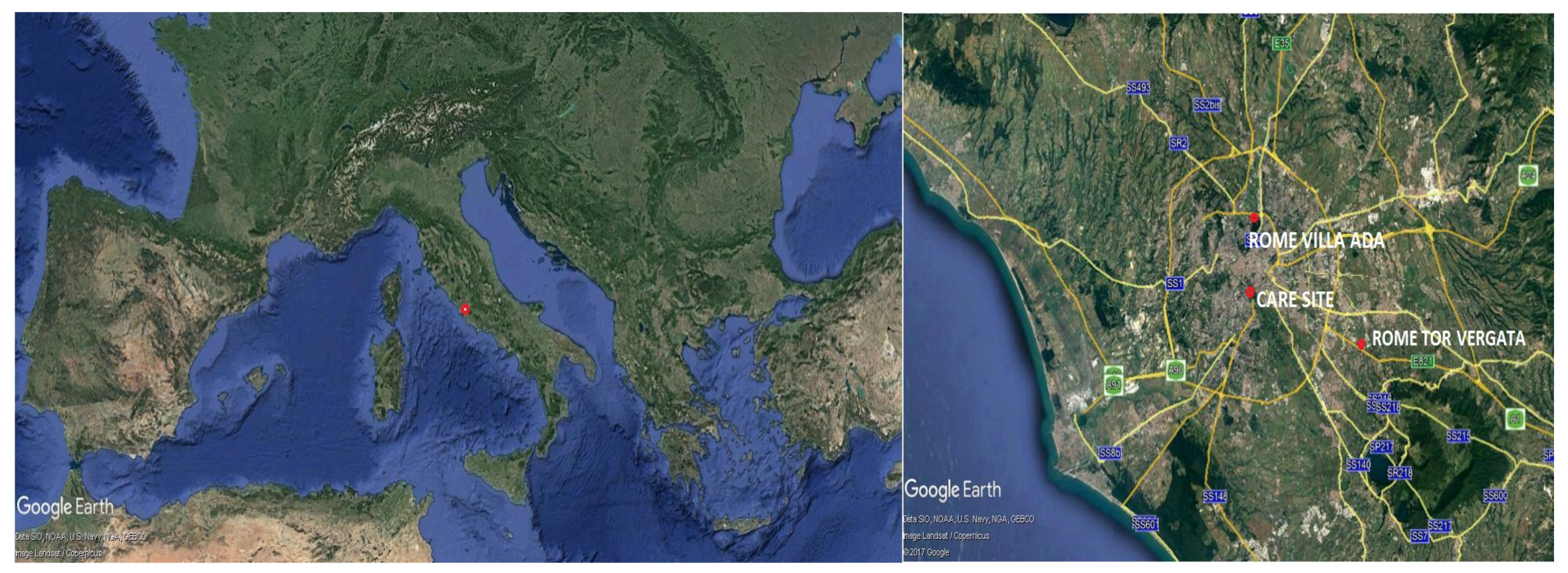
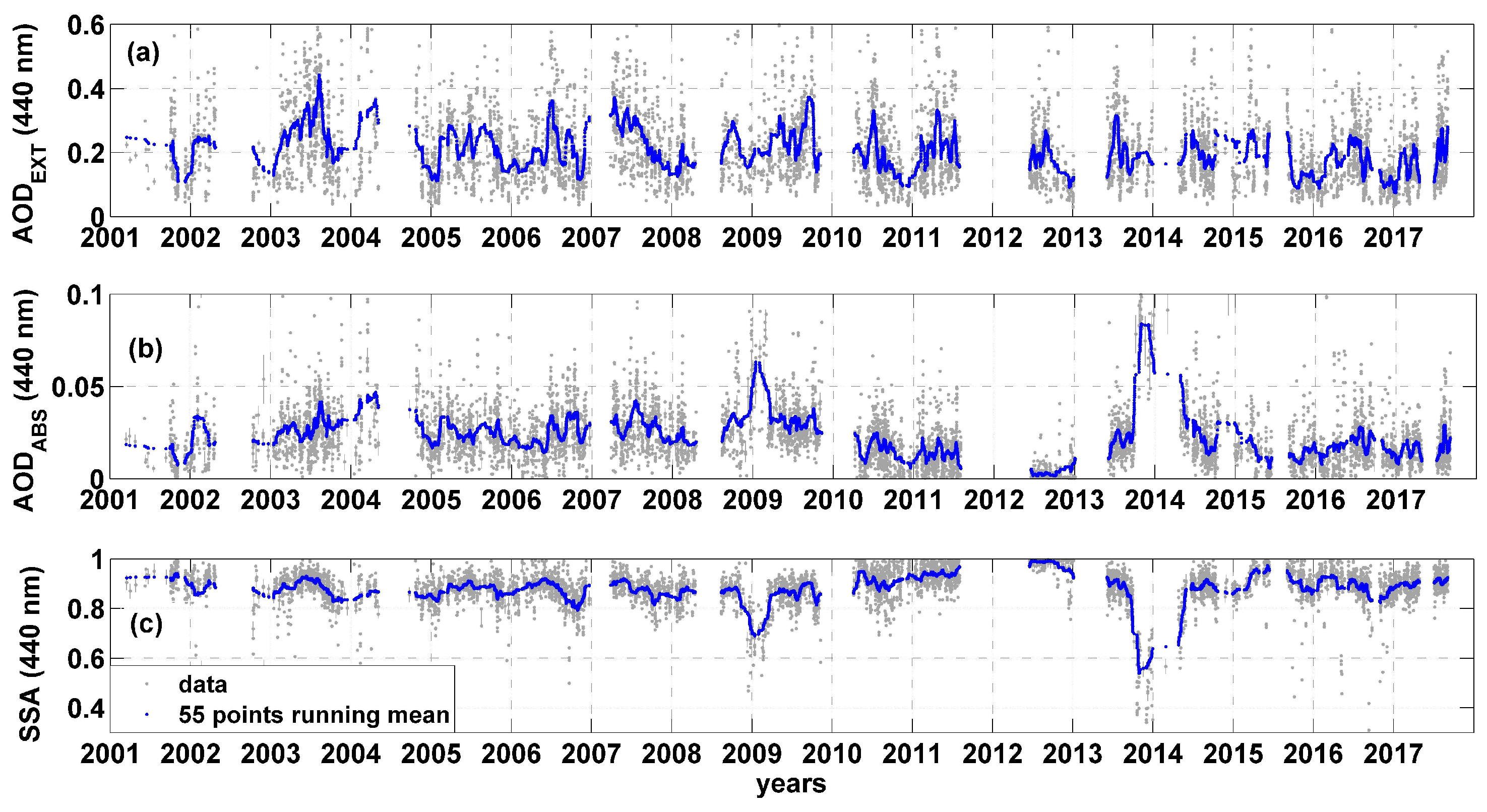
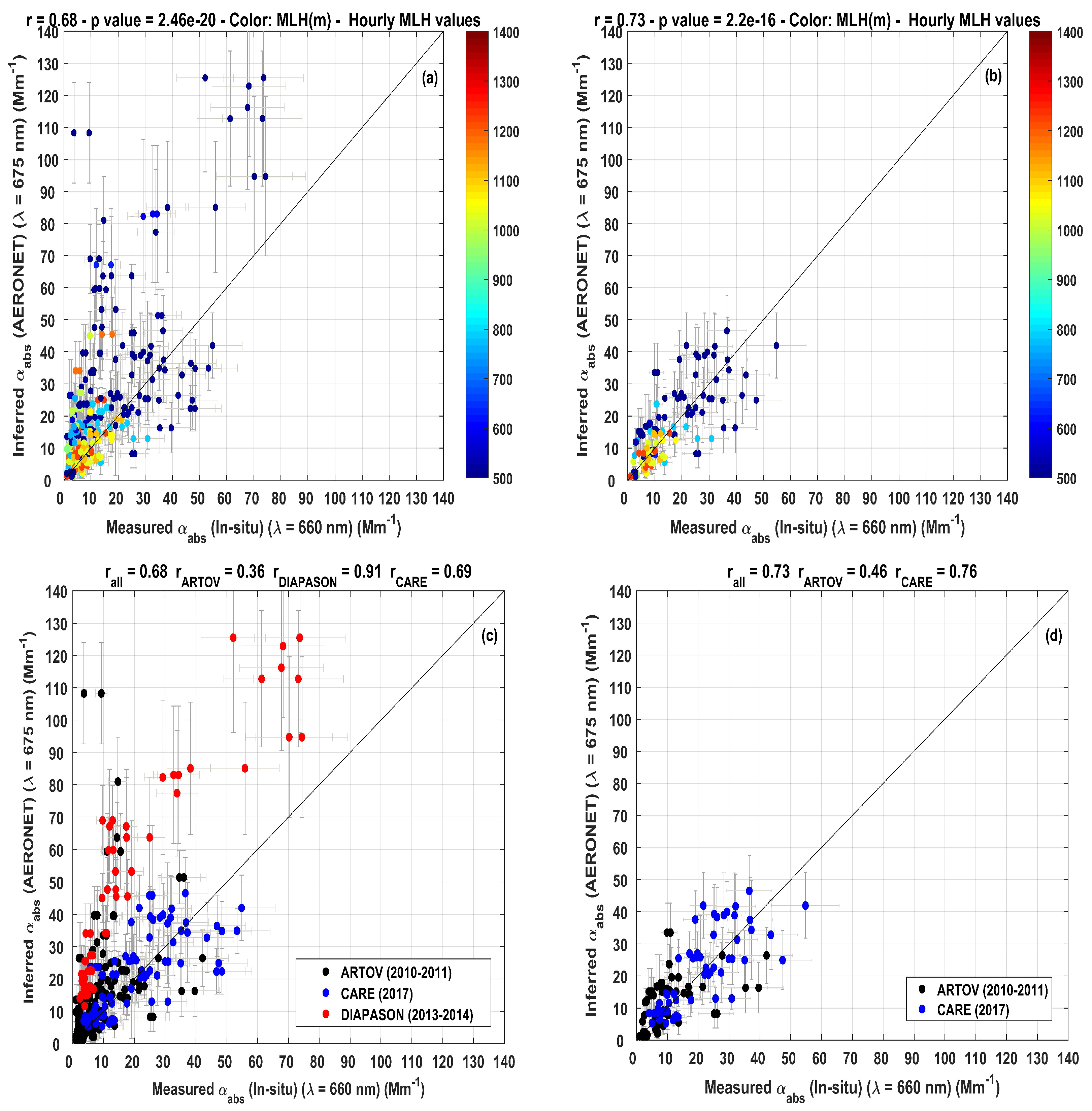
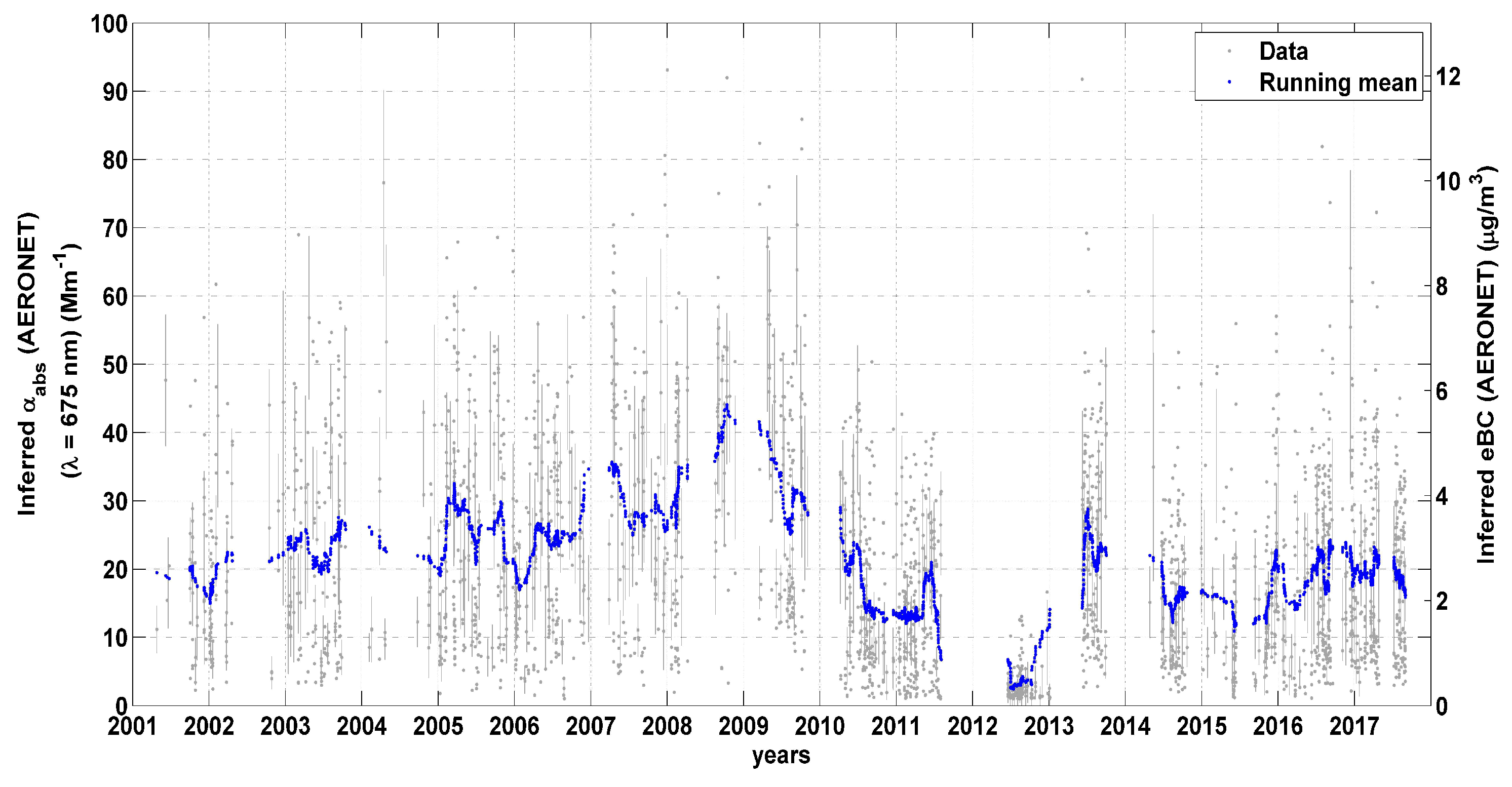
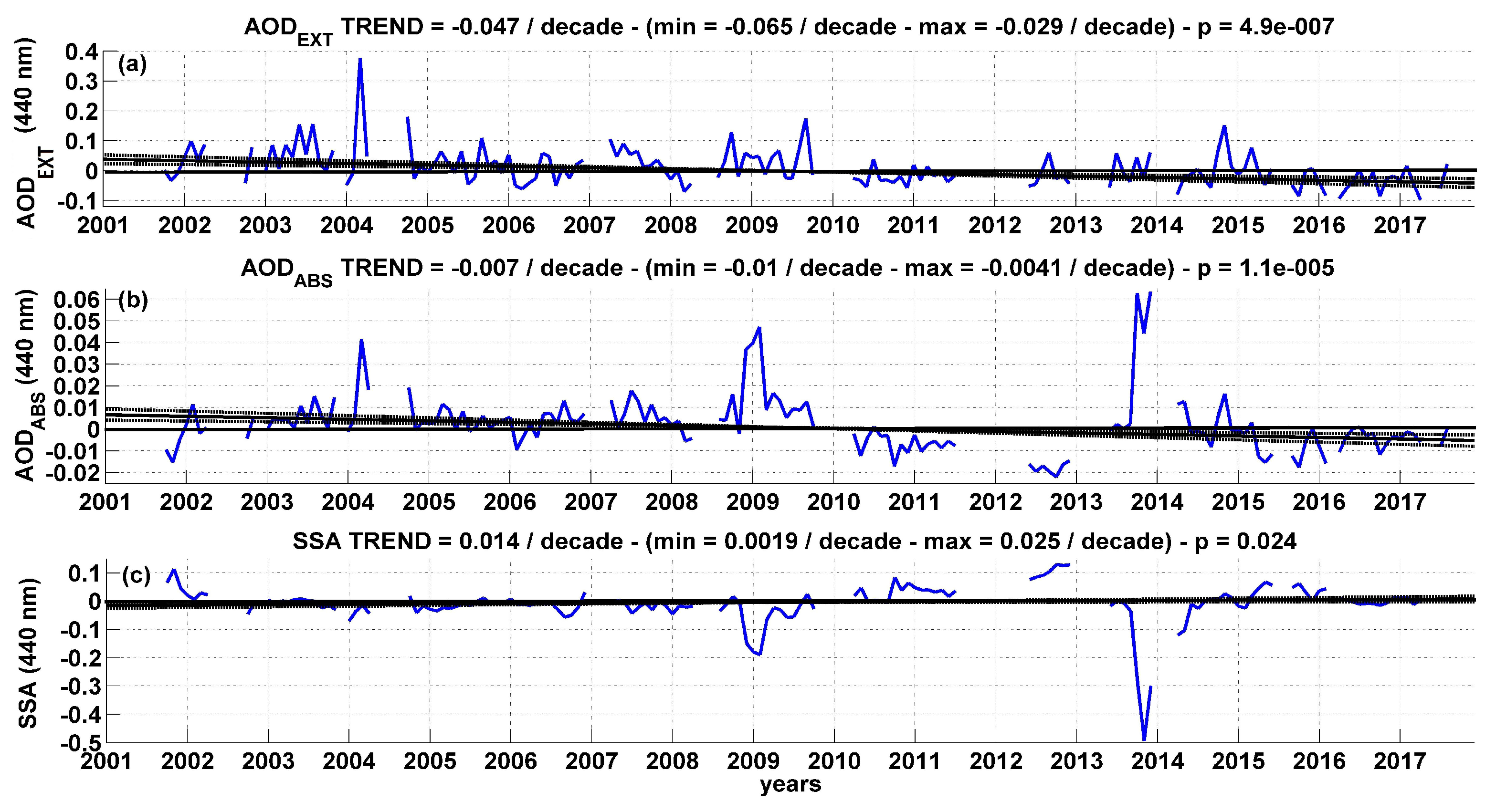

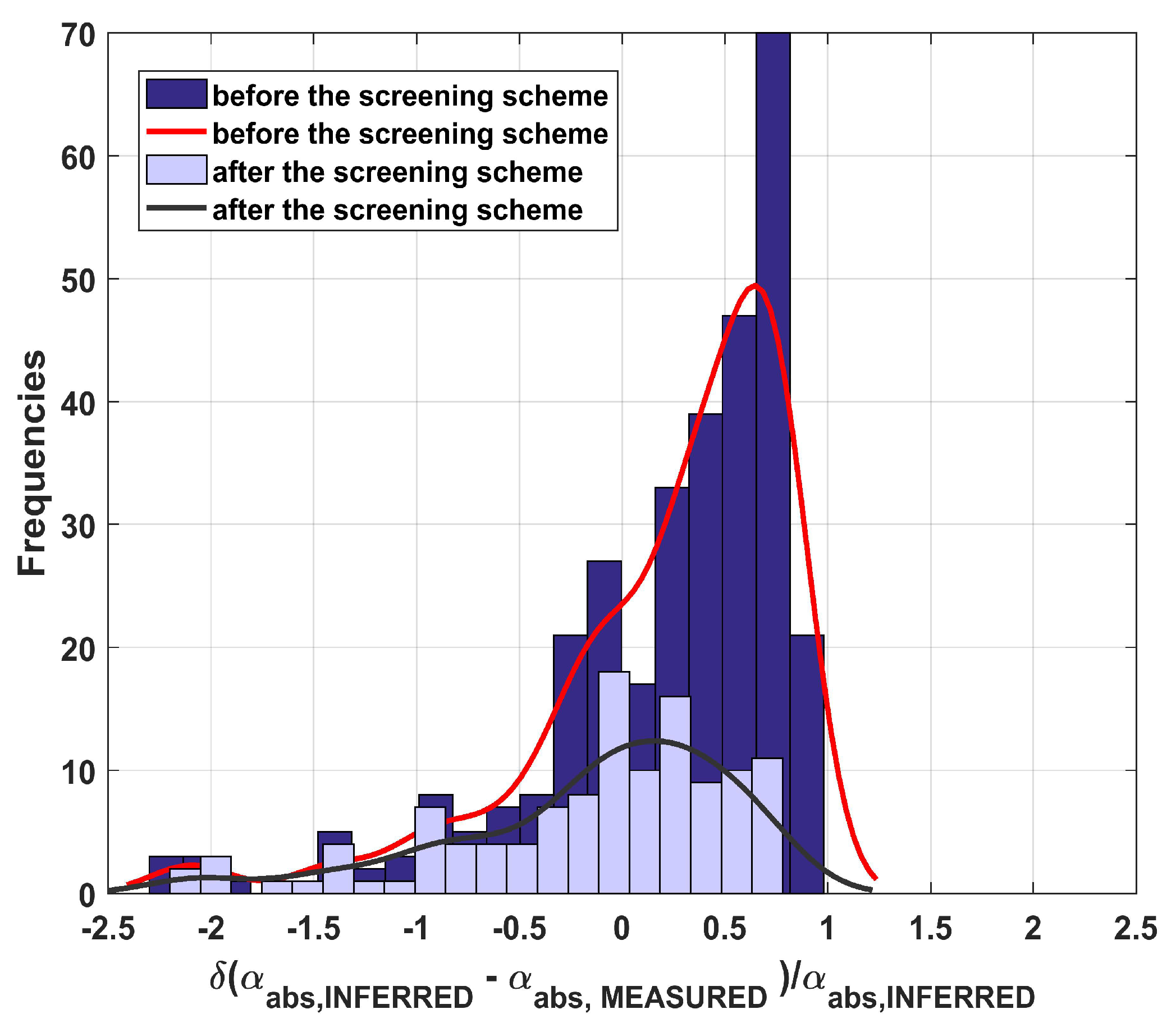
| Criterium | Thresholds |
|---|---|
| T1 | 0.08 < AODEXT (440 nm) < 0.32 |
| T2 | SSA440 > 0.85 |
| T3 | Reff < 0.3 m |
| Season | Before | After |
|---|---|---|
| Winter | 1238 | 539 |
| Spring | 1424 | 602 |
| Summer | 2895 | 1270 |
| Fall | 1669 | 513 |
| Total | 7226 | 2924 |
| “Pure” Dust | “Pure” Black Carbon |
|---|---|
| SAE467–660 < 0.5 | SAE467–660 ≈ 1–3 |
| SSA530 > 0.85 | SSA530 < 0.85 |
| AAE467–660 ≈ 2 | AAE467–660 < 2 |
| dSSA × AAE > 0 | dSSA × AAE < 0 |
| Site | Classification | Period | Coincident Measurements | All Data | ||||
|---|---|---|---|---|---|---|---|---|
| eBC () | eBC () | |MD (%)| | eBC () | eBC () | |MD (%)| | |||
| In-Situ | Inferred | In-Situ | Inferred | |||||
| Rome Tor Vergata (ARTOV 2010) | UB | November 2010 | 0.90±0.35 | 1.87±1.04 | 70% | 1.23 ± 1.58 | 1.43 ± 0.97 | 15% |
| Rome Tor Vergata (ARTOV 2011) | UB | January–February 2011 | 1.61 ± 1.11 | 2.10 ± 1.70 | 26% | 1.77 ± 1.69 | 1.95 ± 1.60 | 10% |
| Rome Tor Vergata (ARTOV 2011) | UB | April–May 2011 | 0.63 ± 0.50 | 2.68 ± 3.73 | 124% | 0.76 ± 0.78 | 3.98 ± 3.19 | 136% |
| Rome Tor Vergata (ARTOV 2011) | UB | June–July 2011 | 0.49 ± 0.58 | 1.64 ± 1.76 | 108% | 0.71 ± 0.65 | 2.22 ± 1.72 | 103% |
| Center Rome (CARE 2017) | UB | February 2017 | 2.70 ± 1.94 | 2.59 ± 1.64 | 4% | 2.60 ± 2.50 [15] | 2.52 ± 1.63 | 1% |
| Rome Villa Ada | UB | Winter (2005–2007) | N/A | N/A | N/A | 2.80 ± 1.60 [61] | 3.51±2.45 | 22% |
| Rome Villa Ada | UB | Summer (2005–2007) | N/A | N/A | N/A | 1.70 ± 0.80 [61] | 4.01 ± 2.58 | 81% |
| Rome Montelibretti | UB | Winter (2005–2010) | N/A | N/A | N/A | 1.40 ± 0.8 [24,61] | 3.77 ± 2.88 | 92% |
| Rome Montelibretti | UB | Summer (2005–2010) | N/A | N/A | N/A | 1.00 ± 0.4 [24,61] | 4.06 ± 2.59 | 121% |
| Site | Type | Time Range | AODEXT/Decade | AODABS/Decade | SSA/Decade | eBC Mass Concentration (/Decade) | Reference |
|---|---|---|---|---|---|---|---|
| Rome Tor Vergata | UB | 2001–2017 | −0.047 | −0.007 | +0.014 | −0.76 | This work |
| Rome Tor Vergata | UB | 2001–2013 | −0.03 | −0.019 | +0.07 | N/A | [46] |
| Ispra | UB | 2001–2013 | −0.03 | −0.002 | −0.026 | N/A | [46,62] |
| Lecce University | UB | 2001–2013 | −0.06 | −0.010 | +0.032 | N/A | [46] |
| Hohenpeissenberg | Mo | 1995–2010 | N/A | N/A | N/A | −0.044 | [63] |
| Avignon | UB | 2001–2013 | −0.02 | −0.004 | +0.027 | N/A | [46] |
| Barcelona | UB | 2001–2013 | −0.07 | −0.008 | +0.028 | N/A | [46] |
© 2018 by the authors. Licensee MDPI, Basel, Switzerland. This article is an open access article distributed under the terms and conditions of the Creative Commons Attribution (CC BY) license (http://creativecommons.org/licenses/by/4.0/).
Share and Cite
Di Ianni, A.; Costabile, F.; Barnaba, F.; Di Liberto, L.; Weinhold, K.; Wiedensohler, A.; Struckmeier, C.; Drewnick, F.; Gobbi, G.P. Black Carbon Aerosol in Rome (Italy): Inference of a Long-Term (2001–2017) Record and Related Trends from AERONET Sun-Photometry Data. Atmosphere 2018, 9, 81. https://doi.org/10.3390/atmos9030081
Di Ianni A, Costabile F, Barnaba F, Di Liberto L, Weinhold K, Wiedensohler A, Struckmeier C, Drewnick F, Gobbi GP. Black Carbon Aerosol in Rome (Italy): Inference of a Long-Term (2001–2017) Record and Related Trends from AERONET Sun-Photometry Data. Atmosphere. 2018; 9(3):81. https://doi.org/10.3390/atmos9030081
Chicago/Turabian StyleDi Ianni, Antonio, Francesca Costabile, Francesca Barnaba, Luca Di Liberto, Kay Weinhold, Alfred Wiedensohler, Caroline Struckmeier, Frank Drewnick, and Gian Paolo Gobbi. 2018. "Black Carbon Aerosol in Rome (Italy): Inference of a Long-Term (2001–2017) Record and Related Trends from AERONET Sun-Photometry Data" Atmosphere 9, no. 3: 81. https://doi.org/10.3390/atmos9030081
APA StyleDi Ianni, A., Costabile, F., Barnaba, F., Di Liberto, L., Weinhold, K., Wiedensohler, A., Struckmeier, C., Drewnick, F., & Gobbi, G. P. (2018). Black Carbon Aerosol in Rome (Italy): Inference of a Long-Term (2001–2017) Record and Related Trends from AERONET Sun-Photometry Data. Atmosphere, 9(3), 81. https://doi.org/10.3390/atmos9030081






